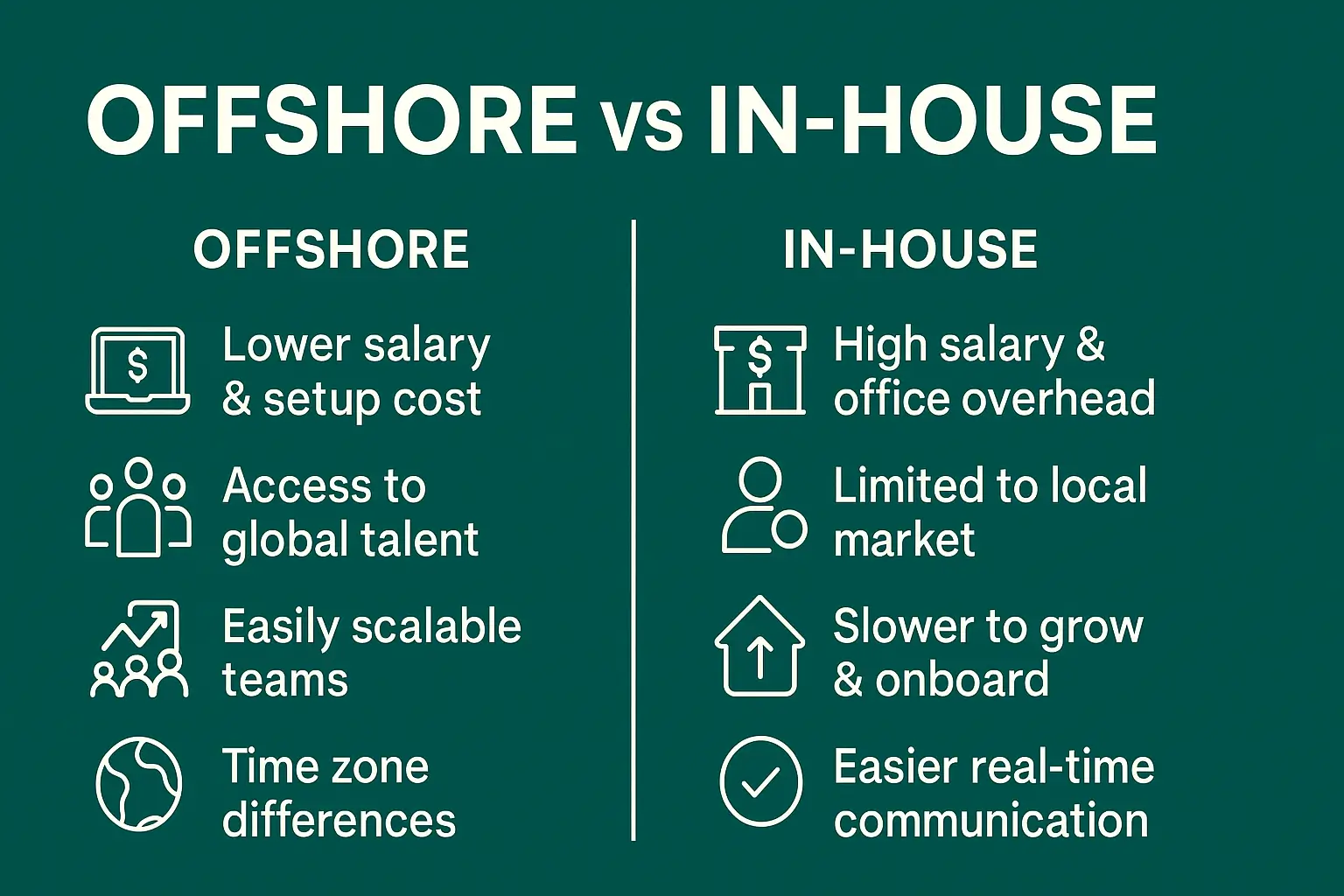Blog
Hiring Offshore vs. In-House: Are You Wasting Money on Local Teams?


TL; DR: Hiring local employees is expensive—think six figures per year. Offshore talent, especially from the Philippines, offers the same quality for a fraction of the cost. You save money, reduce overhead, and keep your business lean and scalable.
Summary: Offshore staffing cuts costs and simplifies hiring without compromising on talent. With lower salaries, fewer overhead expenses, and flexible scaling, it’s a practical way to grow lean. Choosing the right partner helps you avoid common pitfalls and stay focused on results.
When scaling your business, one of the biggest questions you face is whether to hire in-house or outsource offshore. While many companies instinctively lean toward local hires for convenience and control, the financial implications often tell a different story. In this article, we’ll break down the real costs, hidden expenses, and the overlooked benefits of hiring offshore—particularly in the Philippines. If you’re concerned about budget efficiency without sacrificing quality, read on.
In the U.S., hiring a mid-level software developer involves several interrelated cost layers beyond salary alone. Employers must factor in total compensation, compliance obligations, and lost productivity due to time off.
Altogether, the total annual cost per developer falls between $110,000 and $169,000, excluding any turnover or hiring expenses.
Overhead expenses persist—even in hybrid or remote setups, as businesses still need to provide essential infrastructure, tools, and support to maintain productivity and data security.
These expenses bring the total annual overhead to about $10,000–$15,000 per employee.
The hiring process brings its own costs, many of which begin before a new hire even starts. From advertising the role to onboarding and setup, each step takes time, money, and internal resources that impact your bottom line.
These combine to a total cost of $4,000–$6,000 per new hire, with higher costs for senior roles.
Losing an employee affects more than your headcount—it disrupts operations, slows momentum, and diverts time and resources toward replacement efforts:
Overall, turnover can cost up to 75% of an employee’s salary, meaning a $100K salary could equate to $75,000 in replacement costs.

The Philippines boasts a highly educated, English-speaking workforce with strong cultural alignment with Western business practices. With over 700,000 graduates entering the workforce annually—many in fields like IT, finance, and communications—the country offers a deep talent pool. Whether you’re hiring customer service agents, developers, marketers, or virtual assistants, you’ll find professionals who are not only qualified but also trained to work with U.S. and Australian companies. To see just how versatile these professionals can be, explore 10 tasks a Filipino VA could handle today.
This is where things get real. The cost of outsourcing in the Philippines can be up to 70% lower than hiring locally. A skilled full-time employee may cost between $1,200–$2,000 per month, depending on the role and experience level. That’s roughly $15,000–$24,000 per year—an all-inclusive cost that often includes not just wages but also equipment, internet, and even HR or compliance support. These bundled efficiencies allow companies to reinvest in growth without lowering quality.
Forget about office space, hardware, or utilities. Offshore staffing providers typically cover most of these infrastructure costs, including internet, IT equipment, and basic administrative support. This setup means you’re not footing the bill for physical overhead; you pay for the talent and ongoing service, not for managing facilities or buying office gear.
Need to scale up quickly? Offshore models make it possible to expand or reduce your team in a matter of weeks—not months—without disrupting operations. Since you’re not tied to long-term contracts or physical office space, adjustments are fast and low-risk. This flexibility is ideal for seasonal projects, pilot programs, or startups testing new markets.
The global business landscape is witnessing a significant shift towards offshore talent. To understand this phenomenon in depth, read The Outsourcing Shift No One Talks About: Why the Philippines Is Replacing Local Hires.
Time zone differences are a real factor, but not a deal-breaker. With asynchronous communication tools like Slack, Trello, Loom, and Notion, teams can easily stay aligned regardless of location. Many Filipino professionals work partial or full shifts that overlap with U.S. business hours, reducing delays in collaboration.
To manage communication effectively, consider these best practices:
Offshoring doesn’t have to mean cutting corners; the key is choosing the right partner. Top offshore providers implement systems to maintain performance and transparency:
Building long-term relationships with offshore staff also improves loyalty and team cohesion over time.
Security should be a top concern, especially when handling sensitive data. Reputable offshore partners operate under strict compliance standards like ISO, GDPR, and SOC 2.
To ensure robust security, implement the following:
| Cost Factor | In-House (US) | Offshore (Philippines) |
| Salary & Benefits | $120,000–$150,000 | $15,000–$24,000 |
| Overhead | $10,000–$15,000 | Included |
| Recruitment/Onboarding | $4,000–$6,000 | Minimal |
| Total Annual Cost | $135,000–$171,000 | $15,000–$24,000 |
Savings: Up to 85% annually per employee
OutsourceKey isn’t just another staffing agency—we’re your long-term growth partner. We specialize in helping startups and SMEs build world-class offshore teams in the Philippines without the stress of managing operations.
Our clients consistently save 60%–70% on hiring costs while boosting productivity and team morale. Whether you’re building your first offshore team or scaling an existing one, we’re with you every step of the way.

Hiring offshore isn’t just about saving money—it’s about working smarter. With the right provider and the right team, you can reduce costs, increase output, and focus more on growing your business. For many modern companies, the question isn’t “Why go offshore?” but rather, “Why haven’t we done it sooner?”
Stop spending more than you need to and start achieving more. Discover how offshore staffing with OutsourceKey can transform your business. Get a free cost comparison and custom hiring plan tailored to your needs.